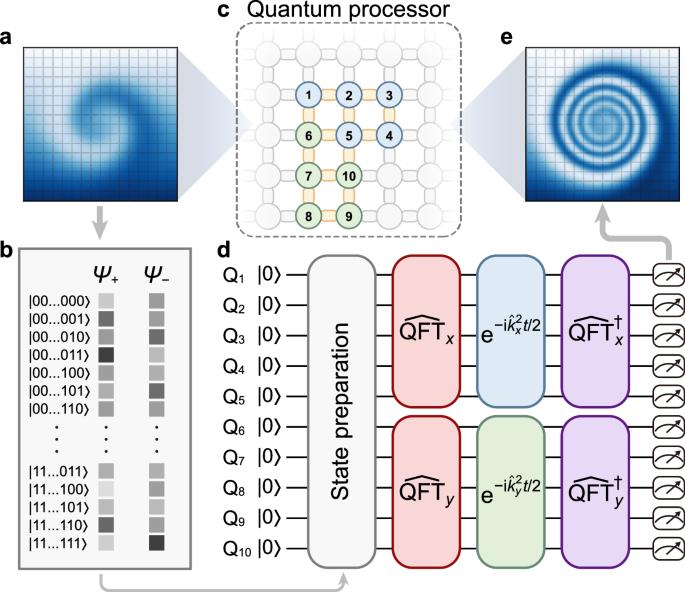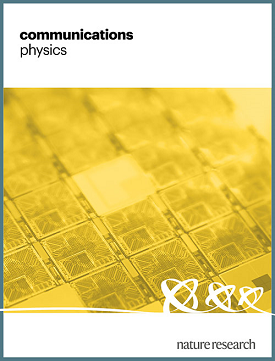Simulating unsteady flows on a superconducting quantum processor
IF 5.4
1区 物理与天体物理
Q1 PHYSICS, MULTIDISCIPLINARY
引用次数: 0
Abstract
Recent advancements of quantum technologies have triggered tremendous interest in exploring practical quantum advantage. The simulation of fluid dynamics, a highly challenging problem in classical physics but vital for practical applications, emerges as a potential direction. Here, we report an experiment on the digital simulation of unsteady flows with a superconducting quantum processor. The quantum algorithm is based on the Hamiltonian simulation using the hydrodynamic formulation of the Schrödinger equation. With the median fidelities of 99.97% and 99.67% for parallel single- and two-qubit gates respectively, we simulate the dynamics of a two-dimensional (2D) compressible diverging flow and a 2D decaying vortex with ten qubits. Note that the former case is an inviscid potential flow, and the latter one is an artificial vortical flow with an external body force. The experimental results well capture the temporal evolution of averaged density and momentum profiles, and qualitatively reproduce spatial flow fields with moderate noises. This work demonstrates the potential of quantum computing in simulating more complex flows, such as turbulence, for practical applications. Fluid dynamics simulation, a complex challenge in classical physics, is relevant for real-world applications and highlights the potential of quantum computing. The authors report an experiment for the digital simulation of unsteady flows on a superconducting quantum processor, and show that the results effectively capture the evolution of flow fields.

在超导量子处理器上模拟非稳态流动
量子技术的最新进展引发了人们对探索实用量子优势的极大兴趣。流体动力学模拟是经典物理学中一个极具挑战性的问题,但对实际应用却至关重要。在此,我们报告了利用超导量子处理器对非稳态流动进行数字模拟的实验。量子算法基于使用薛定谔方程流体力学公式的哈密顿模拟。并行单量子比特和双量子比特门的中位保真度分别为 99.97% 和 99.67%,我们用十个量子比特模拟了二维(2D)可压缩发散流和二维衰减漩涡的动力学。需要注意的是,前一种情况是不粘性势流,后一种情况是带有外部体力的人工涡流。实验结果很好地捕捉了平均密度和动量剖面的时间演化,并定性地再现了中等噪声的空间流场。这项工作展示了量子计算在实际应用中模拟湍流等更复杂流动的潜力。流体动力学模拟是经典物理学中的一项复杂挑战,与现实世界的应用息息相关,凸显了量子计算的潜力。作者报告了在超导量子处理器上对非稳态流动进行数字模拟的实验,并表明实验结果有效地捕捉了流场的演变。
本文章由计算机程序翻译,如有差异,请以英文原文为准。
求助全文
约1分钟内获得全文
求助全文
来源期刊

Communications Physics
Physics and Astronomy-General Physics and Astronomy
CiteScore
8.40
自引率
3.60%
发文量
276
审稿时长
13 weeks
期刊介绍:
Communications Physics is an open access journal from Nature Research publishing high-quality research, reviews and commentary in all areas of the physical sciences. Research papers published by the journal represent significant advances bringing new insight to a specialized area of research in physics. We also aim to provide a community forum for issues of importance to all physicists, regardless of sub-discipline.
The scope of the journal covers all areas of experimental, applied, fundamental, and interdisciplinary physical sciences. Primary research published in Communications Physics includes novel experimental results, new techniques or computational methods that may influence the work of others in the sub-discipline. We also consider submissions from adjacent research fields where the central advance of the study is of interest to physicists, for example material sciences, physical chemistry and technologies.
 求助内容:
求助内容: 应助结果提醒方式:
应助结果提醒方式:


